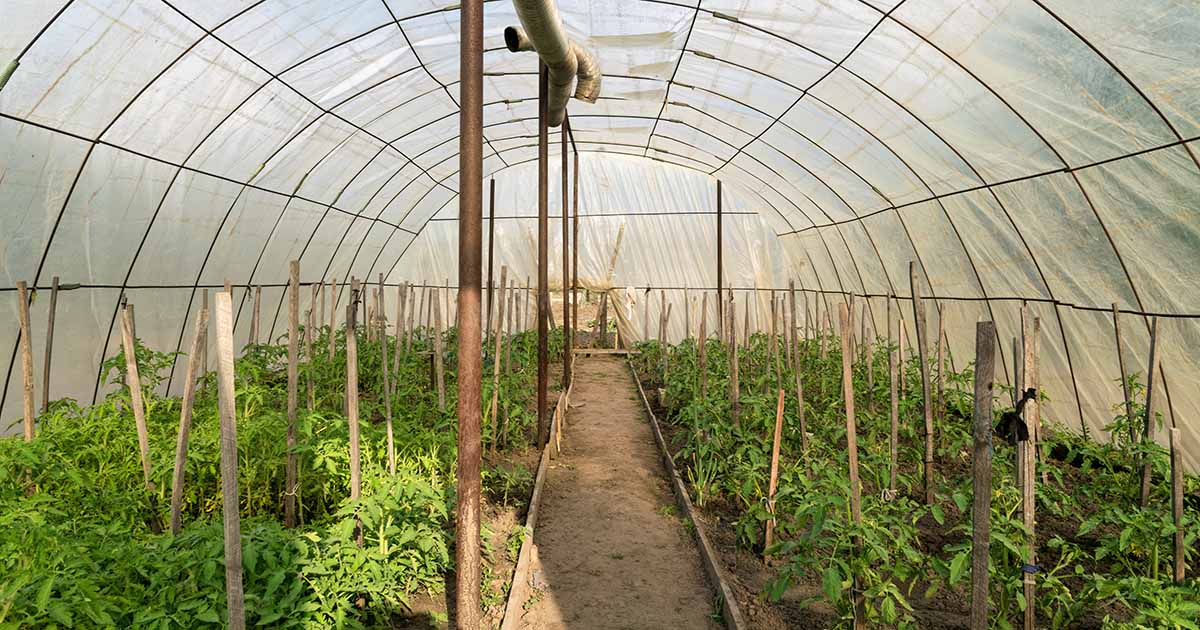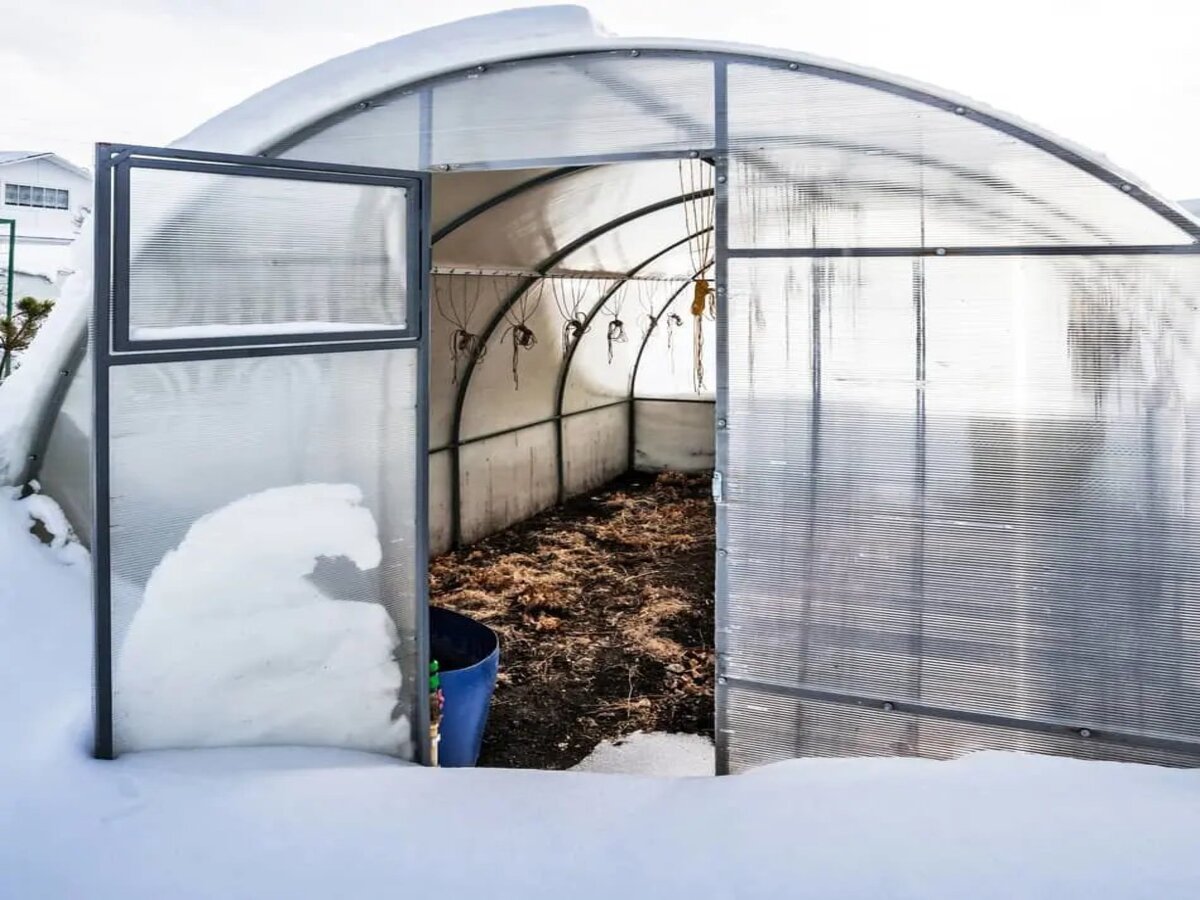Home>Gardening News and Trends>How Does Earth’s Atmosphere Resemble A Greenhouse?


Gardening News and Trends
How Does Earth’s Atmosphere Resemble A Greenhouse?
Modified: January 22, 2024
Discover the Latest News on How Earth's Atmosphere Functions Like a Greenhouse, Trapping Heat and Influencing Climate. Explore This Fascinating Phenomenon!
(Many of the links in this article redirect to a specific reviewed product. Your purchase of these products through affiliate links helps to generate commission for Chicagolandgardening.com, at no extra cost. Learn more)
Table of Contents
Introduction
The Earth’s atmosphere is a complex and dynamic system that plays a crucial role in sustaining life on our planet. It is composed of various gases, such as nitrogen, oxygen, carbon dioxide, and trace amounts of other elements. These gases create a protective layer around the Earth, shielding it from harmful solar radiation and regulating its temperature.
One of the fascinating phenomena that occur within the Earth’s atmosphere is the greenhouse effect. This natural process is instrumental in maintaining the Earth’s temperature within a habitable range, making it suitable for the existence of life as we know it. The greenhouse effect is often compared to the conditions found inside a greenhouse, hence the name.
In this article, we will delve into the similarities between Earth’s atmosphere and a greenhouse, exploring the mechanisms behind the greenhouse effect and its significance for our planet. Additionally, we will discuss the role of greenhouse gases, the importance of the ozone layer, and the impact of human activities on the greenhouse effect.
By understanding the parallels between Earth’s atmosphere and a greenhouse, we can gain insights into the delicate balance that supports life on our planet and the importance of preserving and protecting this vital system.
The Composition of Earth’s Atmosphere
Earth’s atmosphere is a mixture of gases that surrounds our planet, extending from the surface all the way into space. The composition of this atmospheric layer is vital for the regulation of temperature and the support of life. Here are the primary gases that make up Earth’s atmosphere:
- Nitrogen (N2): Nitrogen is the most abundant gas in the Earth’s atmosphere, accounting for approximately 78% of its composition. It is an essential element for living organisms and plays a crucial role in the growth and development of plants.
- Oxygen (O2): Oxygen makes up around 21% of the Earth’s atmosphere. It is vital for the survival of most forms of life, including humans, as it is necessary for respiration and the production of energy.
- Carbon Dioxide (CO2): Carbon dioxide is a greenhouse gas and constitutes a mere 0.04% of Earth’s atmosphere. While it is present in small amounts, its role in the greenhouse effect and climate regulation is significant. Plants also rely on carbon dioxide during photosynthesis.
- Other Trace Gases: There are various other gases present in trace amounts in Earth’s atmosphere. These include noble gases like argon, neon, and helium, as well as pollutants such as ozone, methane, and water vapor.
It is important to note that the composition of Earth’s atmosphere can vary depending on altitude and location. For instance, at higher altitudes, the density of gases decreases, making it more challenging for humans and other organisms to breathe.
Overall, the combination of these gases in Earth’s atmosphere creates the ideal conditions for supporting life, maintaining stable temperatures, and protecting the planet from harmful solar radiation.
The Greenhouse Effect Explained
The greenhouse effect is a natural process that helps regulate the Earth’s temperature, making it suitable for life. It refers to the trapping of heat within the Earth’s atmosphere due to the presence of certain gases, known as greenhouse gases. These gases act like a blanket, allowing sunlight to pass through but preventing some of the heat from escaping back into space.
When solar radiation reaches the Earth’s surface, it is absorbed and re-radiated as heat. Some of this heat is then trapped by greenhouse gases, such as carbon dioxide, methane, and water vapor, which have the ability to absorb and re-emit infrared radiation. This process effectively warms the atmosphere and the Earth’s surface.
The greenhouse effect is essential for maintaining the Earth’s average temperature at around 15 degrees Celsius (59 degrees Fahrenheit). Without it, the Earth would be too cold to support life as we know it. However, human-induced activities, such as the burning of fossil fuels and deforestation, have increased the concentration of greenhouse gases in the atmosphere, leading to an enhanced greenhouse effect and global warming.
It is important to note that the greenhouse effect itself is not harmful. In fact, it is a natural phenomenon that has been occurring for billions of years. It is the imbalance caused by human activities that is of concern. The increased concentration of greenhouse gases in the atmosphere traps more heat, contributing to a rise in global temperatures, altered climate patterns, and adverse effects on ecosystems and biodiversity.
Understanding the greenhouse effect is crucial in addressing global warming and climate change. By reducing greenhouse gas emissions, adopting sustainable practices, and promoting renewable energy sources, we can mitigate the impact of human activities on the greenhouse effect and work towards a more sustainable future.
Similarities between Earth’s Atmosphere and a Greenhouse
Despite their differences in scale, there are several striking similarities between Earth’s atmosphere and a greenhouse. These similarities help us understand the mechanisms of the greenhouse effect and its impact on our planet. Here are some key resemblances:
- Trapping of heat: Just like a greenhouse, Earth’s atmosphere acts as a protective layer that traps heat. In a greenhouse, the glass walls allow sunlight to enter and warm the interior, while preventing the escape of heat. In the same way, certain greenhouse gases in the Earth’s atmosphere allow sunlight in but impede the escape of infrared radiation, resulting in the warming of the Earth’s surface.
- Regulation of temperature: In a greenhouse, the controlled environment helps maintain a stable and favorable temperature for plant growth. Similarly, Earth’s atmosphere plays a crucial role in regulating the planet’s temperature, ensuring it remains within a range suitable for supporting life as we know it.
- Importance of transparency: In a greenhouse, the transparent glass permits visible light to enter, necessary for plant photosynthesis. Likewise, the Earth’s atmosphere allows sunlight, particularly the visible light spectrum, to reach the surface, enabling photosynthesis in plants and the sustenance of ecosystems.
- Retention of moisture: Greenhouses often require controlled levels of humidity to support plant growth. Similarly, Earth’s atmosphere retains water vapor, an important greenhouse gas, which helps regulate temperature and maintain climatic conditions necessary for life.
- Human influence: Both greenhouses and the Earth’s atmosphere are subject to human influence. In a greenhouse, human activities such as adjusting temperature settings and providing supplemental lighting can impact plant growth. Similarly, human activities, particularly the burning of fossil fuels and deforestation, increase the concentration of greenhouse gases in the Earth’s atmosphere, leading to an enhanced greenhouse effect and global warming.
These similarities between Earth’s atmosphere and a greenhouse provide valuable insights into the mechanisms at play in climate regulation. By studying and understanding these parallels, we can develop strategies and solutions to mitigate the negative impact of human activities on the Earth’s climate system and work towards a more sustainable and balanced future.
The Role of Greenhouse Gases
Greenhouse gases play a crucial role in the Earth’s climate system by contributing to the greenhouse effect. These gases have the ability to absorb and emit infrared radiation, trapping heat in the atmosphere and regulating the planet’s temperature. Here are some key greenhouse gases and their respective roles:
- Carbon Dioxide (CO2): Carbon dioxide is one of the primary greenhouse gases responsible for the greenhouse effect. It is released into the atmosphere through natural processes like respiration and volcanic eruptions, as well as human activities such as burning fossil fuels and deforestation. The increased concentration of carbon dioxide in the atmosphere is a major contributor to global warming.
- Methane (CH4): Methane is another potent greenhouse gas. It is released during natural processes like the decomposition of organic matter and the digestive processes of certain animals. Human activities such as agriculture (rice cultivation and livestock farming) and the production and transportation of coal, oil, and natural gas contribute to methane emissions. Methane is a particularly potent greenhouse gas, capable of trapping significantly more heat than carbon dioxide.
- Nitrous Oxide (N2O): Nitrous oxide is a greenhouse gas released through natural processes like bacterial processes in soils and the burning of fossil fuels. Human activities such as industrial and agricultural practices, including the use of synthetic fertilizers, contribute to nitrous oxide emissions. Nitrous oxide has a significant warming effect as well as being a major contributor to ozone depletion.
- Water Vapor (H2O): While water vapor is not directly controlled by human activities, it is a significant greenhouse gas. It is essential for the greenhouse effect and plays a critical role in regulating the Earth’s temperature. Increased temperatures due to other greenhouse gases can cause an increase in water vapor, further amplifying the greenhouse effect.
Greenhouse gases are instrumental in maintaining a habitable temperature on Earth. Without them, the planet would be much colder, potentially uninhabitable. However, human activities have resulted in an imbalance in the concentration of these gases, leading to an enhanced greenhouse effect and detrimental consequences for the climate system.
Understanding the role of greenhouse gases underscores the importance of adopting sustainable practices and reducing greenhouse gas emissions. By transitioning to renewable energy sources, increasing energy efficiency, and promoting reforestation efforts, we can help mitigate the impact of greenhouse gases on our planet’s climate and work towards a more sustainable future.
The Importance of the Ozone Layer
The ozone layer, located in the Earth’s stratosphere, plays a crucial role in protecting life on our planet. It acts as a shield, absorbing and filtering out harmful ultraviolet (UV) radiation from the sun. The importance of the ozone layer cannot be overstated, as it provides several essential benefits:
- UV radiation protection: The ozone layer acts as a filter, absorbing the majority of the sun’s harmful UVB and UVC rays. These rays are known to cause damage to DNA, leading to skin cancer, eye cataracts, and weakened immune systems. Without the ozone layer, life on Earth would be exposed to high levels of dangerous UV radiation, making it difficult for most organisms to survive.
- Ecosystem support: Ozone depletion can have significant impacts on ecosystems. UV radiation can inhibit the growth and development of phytoplankton, which forms the base of the marine food web. Reduced levels of phytoplankton would disrupt the entire marine ecosystem, affecting fish populations and the livelihoods of millions of people who depend on them for food and income.
- Protection of terrestrial life: The ozone layer also plays a critical role in supporting terrestrial life. UV radiation can damage plants, affecting photosynthesis rates and crop yields. This can have far-reaching consequences for agriculture and food security, impacting both human and animal populations that rely on these resources.
- Climate regulation: The ozone layer is intricately linked to climate regulation. It affects the atmosphere’s temperature structure and circulation patterns. Changes in the ozone layer can influence weather patterns, impacting rainfall, wind patterns, and overall climate stability.
- Preservation of biodiversity: The ozone layer helps protect biodiversity by supporting healthy ecosystems. It preserves the intricate balance of species interactions and environmental conditions necessary for the survival of a wide range of plant and animal species.
It is important to note that human activities have led to the depletion of the ozone layer, primarily through the release of ozone-depleting substances (ODS) like chlorofluorocarbons (CFCs). However, international efforts, such as the Montreal Protocol, have successfully phased out the production and use of ODS, resulting in the gradual healing of the ozone layer.
Protecting and preserving the ozone layer is essential for the well-being of our planet and future generations. Continued efforts to reduce ozone-depleting substances, promote sustainable practices, and raise awareness about the importance of the ozone layer are crucial for maintaining the delicate balance of our global ecosystem.
The Impact of Human Activities on the Greenhouse Effect
Human activities have had a significant impact on the greenhouse effect, leading to an imbalance in the Earth’s climate system. The burning of fossil fuels, deforestation, industrial processes, and agricultural practices have all contributed to an increase in the concentration of greenhouse gases in the atmosphere. Here are some key ways in which human activities have influenced the greenhouse effect:
- Burning of Fossil Fuels: The combustion of fossil fuels, such as coal, oil, and natural gas, releases large amounts of carbon dioxide into the atmosphere. These greenhouse gas emissions have been amplified by the increased demand for energy and transportation, contributing to the enhanced greenhouse effect and global warming.
- Deforestation: The clearing of forests has a twofold effect on the greenhouse effect. First, the loss of trees leads to a reduction in the uptake of carbon dioxide through photosynthesis. Second, when forests are burned or decomposed, carbon dioxide is released back into the atmosphere. Deforestation also results in the loss of biodiversity and the destruction of crucial carbon sinks.
- Industrial Processes: Industrial activities, including manufacturing, mining, and chemical production, release various greenhouse gases into the atmosphere. These include methane, nitrous oxide, and fluorinated gases. The expansion of industrialization has significantly contributed to the overall increase in greenhouse gas emissions.
- Agricultural Practices: Certain agricultural practices, such as the use of synthetic fertilizers, livestock farming, and rice cultivation, release significant amounts of methane and nitrous oxide. Methane is released during the digestive processes of ruminant animals like cattle, while nitrous oxide is produced through the breakdown of nitrogen-based fertilizers. These agricultural emissions are major contributors to the greenhouse effect.
- Waste Management: Improper waste management, particularly the decomposition of organic waste in landfills, produces methane. Methane is a potent greenhouse gas, with a warming potential much higher than carbon dioxide. The improper handling of waste exacerbates the greenhouse effect and contributes to climate change.
The impact of these human activities on the greenhouse effect has resulted in global warming, altered climate patterns, and environmental consequences. It has led to rising sea levels, melting ice caps, extreme weather events, and disruptions to ecosystems worldwide.
Recognizing and mitigating the impact of human activities on the greenhouse effect is crucial for preserving the well-being of our planet. By transitioning to renewable energy sources, adopting sustainable agricultural practices, promoting afforestation and reforestation efforts, and embracing circular economies, we can work towards reducing greenhouse gas emissions, mitigating climate change, and creating a more sustainable future for generations to come.
Conclusion
The Earth’s atmosphere and the greenhouse effect are intricately connected, playing a vital role in sustaining life on our planet. The composition of Earth’s atmosphere, with its mixture of gases, regulates temperature, shields from harmful radiation, and enables the existence of diverse ecosystems. Similarly, the greenhouse effect, resembling the conditions found in a greenhouse, helps maintain Earth’s temperature within a habitable range.
However, human activities have disrupted this delicate balance by releasing excessive amounts of greenhouse gases into the atmosphere. The burning of fossil fuels, deforestation, industrial processes, and agricultural practices have all contributed to an enhanced greenhouse effect, leading to global warming and climate change.
Understanding the role of greenhouse gases, the importance of the ozone layer, and the impact of human activities on the greenhouse effect is crucial for addressing these challenges and working towards a sustainable future. By embracing renewable energy sources, adopting sustainable practices, conserving forests, reducing emissions, and promoting international cooperation, we can mitigate the negative effects of human activities on the Earth’s climate system.
Preserving and protecting our atmosphere is not just an environmental obligation; it is a responsibility to future generations. As stewards of this planet, we must prioritize sustainable practices that reduce greenhouse gas emissions, promote biodiversity, and safeguard the health of our ecosystems.
By working collectively towards a greener and more sustainable future, we can ensure that the Earth’s atmosphere continues to provide the necessary conditions for life to thrive. Let us strive for innovative solutions and engage in global efforts to restore the balance of the greenhouse effect, ensuring a healthier and more resilient planet for ourselves and future generations.








